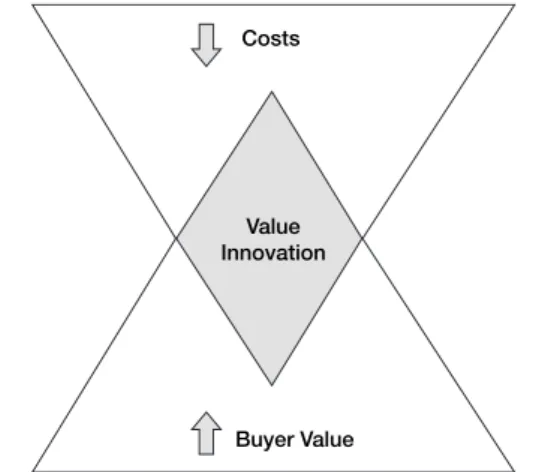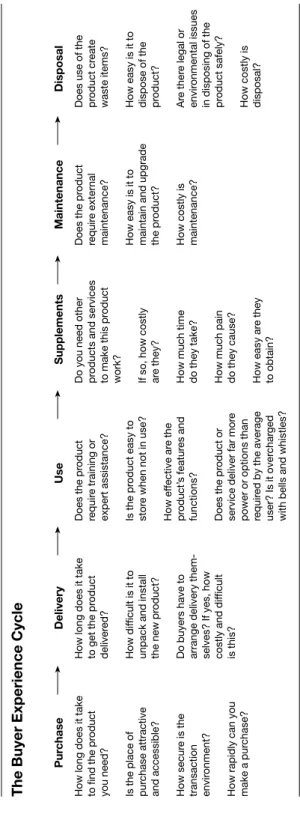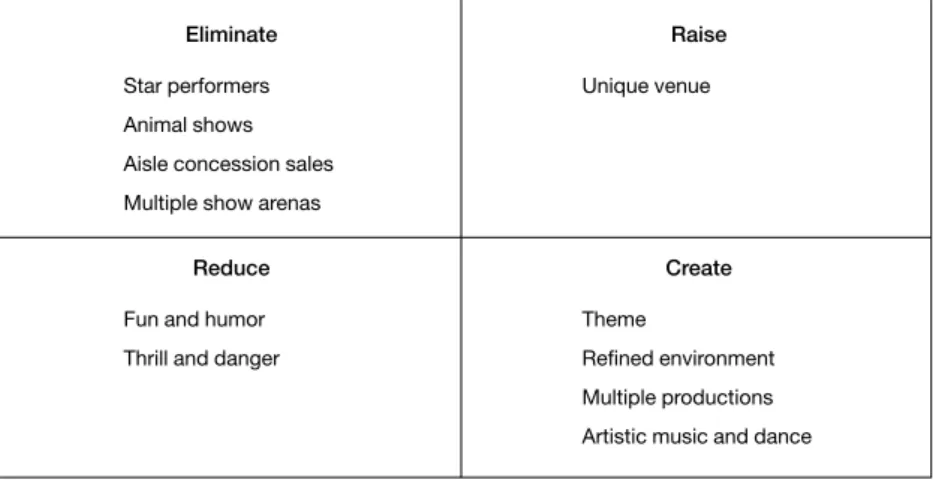Blue ocean strategy challenges companies to avoid the red ocean of bloody competition by creating an uncontested market space that renders competition irrelevant. These three characteristics serve as an initial litmus test of the commercial viability of blue ocean ideas. When the value curve of a company or its competitors meets the three criteria that define a good blue ocean strategy—focus, divergence, and a compelling tagline that speaks to the market—the company is on the right track.
These three criteria serve as an initial litmus test of the commercial viability of blue ocean ideas.

Look Across Alternative Industries
On the one hand, company management may fly in business or first class on a commercial airline. On the other hand, a company can purchase its own aircraft for business travel. By focusing on the key factors that drive corporations to trade between alternatives and eliminate or reduce everything else, NetJets has created its Blue Ocean Strategy.
On the one hand, commercial travel avoids the high upfront fixed cost investment of a multi-million dollar jet. Nor is it to pay so-called deadhead costs – the cost of flying the aircraft from its home base where needed. On the other hand, the distinctive strengths of mobile phones were their mobility, voice transmission and ease of use.
This dramatically reduces the number of bills users receive and eliminates the need to provide credit card details as they do online. By offering the decisive advantages of both alternative industries—and eliminating or reducing everything else—Home Depot has transformed the huge latent demand for home improvement into real demand, turning ordinary homeowners into do-it-yourselfers. By focusing on the key factors that drive buyers to trade across alternative industries and eliminating or reducing everything else, you can create a blue ocean of new market space.
Look Across Strategic Groups Within Industries
For example, Mercedes, BMW and Jaguar focus on outperforming each other in the luxury car segment, while fuel-efficient car manufacturers focus on outperforming each other in their strategic group. Membership fees for all of this are typically around $100 per month – not cheap, which ensures the market remains upscale and small. The clients of traditional health clubs represent only 12 percent of the entire population and are mostly concentrated in the larger metropolitan areas.
It's hard to be disciplined in the confines of one's home if you're not already a dedicated sports enthusiast. The member enters the exercise room where the machines (usually about ten) are arranged, not in rows facing a television as in the health club, but in a circle to facilitate exchange between members, making the experience fun. 1 million for traditional health clubs, start-up investments for Curves are in the range of only $25,000 to $30,000 (excluding a . $20,000 franchise fee) due to the wide variety of factors the company has eliminated.
In the luxury car market, Toyota's Lexus created a new blue ocean by offering the quality of high-end Mercedes, BMW and Jaguar at a price point closer to low-end Cadillac and Lincoln. Seeing the high fidelity of boom boxes at the price and low portability of transistor radios within the audio equipment industry, Sony created the personal portable-stereo market in the late 1970s. Michigan-based Champion Enterprises identified a similar opportunity by looking two strategic groups in the housing industry: prefabricated housing manufacturers and field developers.
Look Across the Chain of Buyers
Consider Novo Nordisk, the Danish insulin manufacturer that created a blue ocean in the insulin industry. Historically, the insulin industry, like most of the pharmaceutical industry, has focused its attention on key influencers: physicians. Because of the importance of physicians in diabetics' insulin purchasing decisions, physicians have become the target group of industry buyers.
Accordingly, the industry turned its attention and efforts to producing purer insulin in response to physicians' search for better medication. However, Novo Nordisk saw it could break away from the competition and create a blue ocean by shifting the industry's longstanding focus from physicians to the users – the patients themselves. Novo Nordisk's blue ocean strategy changed the industrial landscape and transformed the company from an insulin producer to a diabetes care company.
The industry focused on buyers—IT managers—who valued standardized systems that made their lives easier. By shifting its focus from buyers to users, Bloomberg created a value curve that was radically different from anything the industry had seen before. Consider how Canon copiers created the small desktop copier industry by shifting the copier industry's target customer from corporate buyers to consumers.
Look Across Complementary Product and Service Offerings
SAP shifted the customer focus of the business application software industry from the functional user to the enterprise buyer to create its hugely successful real-time integrated software business. Under the accepted rules of competition in the industry, the companies competed to offer the lowest purchase price. Why were the bus companies only focused on the original purchase price of the bus, when the municipalities kept buses in circulation for twelve years on average.
NABI discovered that the highest cost element for municipalities was not the price of the bus itself, the factor on which the entire industry competed, but rather the costs that came after the bus was purchased: the maintenance of running the bus over its 12-year life cycle. As a result, although NABI charged a higher initial purchase price than the average price for the industry, it offered its buses at a much lower life cycle cost to municipalities. It has accumulated more than $1 billion in orders and was named by the Economist Intelligence Unit in October 2002 as one of the thirty most successful companies in the world.
By thinking in terms of complementary products and services, Philips saw that the biggest problem the British had in brewing tea was not in the kettle itself, but in the complementary product of water, which had to be boiled in the kettle become Borders and Barnes & Noble (B&N) superstores have redefined the scope of the services they offer. In less than six years, Borders and B&N emerged as the two largest bookstore chains in the United States, with more than one thousand and seventy superstores between them.
Look Across Functional or Emotional Appeal to Buyers
Rather, it's usually a result of the way companies have competed in the past, which unconsciously educated consumers about what to expect. QB House has created a blue ocean in the Japanese barbershop industry and is growing rapidly throughout Asia. At the heart of QB House's blue ocean strategy is the shift in the Asian barbershop industry from an emotional industry to a high-end one.
As a result, the actual time spent cutting hair is a fraction of the total time. Cemex, the world's third-largest cement producer, is another company that has created a blue ocean by shifting its industry's orientation – this time in the opposite direction, from functional to sustainable. In Mexico, cement sold in bags to the average do-it-yourselfer represents over 85 percent of the total cement market.4 However, the market was unattractive in the current situation.
Cemex conservatively estimated that this market could grow to $500 to $600 million annually if it could unleash this latent demand.5 Cemex's answer to this dilemma came in 1998 with the launch of the Patrimonio Hoyprogram, which changed cement's focus from a functional product to the gift of dreams. The explosion of blue ocean creation is taking place in many service industries, but in the opposite direction - from an emotional to a functional orientation. In the United States, The Vanguard Group (in index funds) and Charles Schwab (in brokerage services) are doing the same thing in the investment industry, creating a blue ocean by transforming emotionally driven, relationship-based businesses into high-performance, low-cost functional businesses. .
Look Across Time
This hypothesis was proven wrong when one of the fastest growing units – the mobile phone business – unveiled its strategy canvas. The question is how to increase the size of the blue ocean you are creating. It is not enough to increase the size of the blue ocean you are creating.
Can you profit at the strategic price—the price that is easily accessible to the mass of target buyers. In the case of the school lunch catering industry, raising this question led to an interesting insight. On the other hand, companies with uncertain patent and asset protection must consider prices somewhere in the middle of the aisle.
Target costing, the next step in the strategic sequence, addresses the profit side of the business model. When a company's offering successfully addresses the profit side of the business model, the company is ready to advance to the final step in the blue ocean strategy sequence. If Monsanto had taken these steps, instead of being maligned, it might have ended up as the "Intel Inside" of food for the future - the provider of the essential technology.
In educating these three stakeholder groups—your employees, your partners, and the general public—the main challenge is to engage in an open discussion about why adoption of the new idea is necessary. Commission salespeople, for example, are rarely sensitive to the costs of the sales they produce. Back in the subway, Bratton discovered that one of the biggest cold spots was processing criminals in court.
With a mayor who speaks aggressively in the press about the need to prosecute crimes that harm the quality of life.

